
The Johnson County War, also known as the War on Powder River and the Wyoming Range War, was a range war in Johnson County, Wyoming from 1889 to 1893. The conflict began when cattle companies started ruthlessly persecuting alleged rustlers in the area, many of whom were settlers who competed with them for livestock, land and water rights. As violence swelled between the large established ranchers and the smaller settlers in the state, it culminated in the Powder River Country, when the ranchers hired gunmen, who invaded the county. The gunmen's initial incursion in the territory alerted the small farmers and ranchers, as well as the state lawmen, and they formed a posse of 200 men that led to a grueling standoff which ended when the United States Cavalry on the orders of President Benjamin Harrison relieved the two forces, although further fighting persisted.

The Rough Riders was a nickname given to the 1st United States Volunteer Cavalry, one of three such regiments raised in 1898 for the Spanish–American War and the only one to see combat. The United States Army was small, understaffed, and disorganized in comparison to its status during the American Civil War roughly thirty years prior. Following the sinking of USS Maine, President William McKinley needed to muster a strong ground force swiftly, which he did by calling for 125,000 volunteers to assist in the war. The U.S. had gone to war in opposition to Spanish colonial policies in Cuba, which was then torn by a rebellion. The regiment was also nicknamed "Wood's Weary Walkers" for its first commander, Colonel Leonard Wood. This reflected their dissatisfaction that despite being cavalry, they ended up fighting in Cuba as infantry, since their horses were not sent there with them.
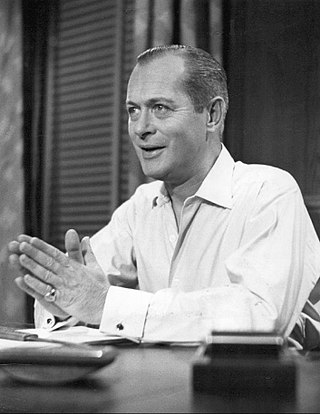
Robert Montgomery was an American actor, director, and producer. He began his acting career on the stage, but was soon hired by MGM. Initially assigned roles in comedies, he soon proved he was able to handle dramatic ones, as well. He appeared in a wide variety of roles, such as the weak-willed prisoner Kent in The Big House (1930), the psychotic Danny in Night Must Fall (1937), and Joe, the boxer mistakenly sent to Heaven in Here Comes Mr. Jordan (1941). The last two earned him nominations for the Academy Award for Best Actor.
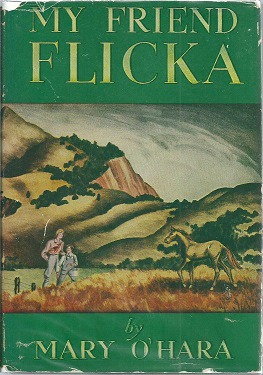
My Friend Flicka is a 1941 novel by Mary O'Hara, about Ken McLaughlin, the son of a Wyoming rancher, and his mustang horse Flicka. It was the first in a trilogy, followed by Thunderhead (1943) and Green Grass of Wyoming (1946). The popular 1943 film version featured young Roddy McDowall and was followed by two other film adaptations, Thunderhead, Son of Flicka (1945), and Green Grass of Wyoming (1948), both based on O'Hara's novels. A My Friend Flicka television series followed during 1956–1957, which first aired on CBS, then on NBC, with reruns on ABC and CBS between 1959 and 1966. The Disney Channel re-ran the program during the mid-1980s.

Lane Chandler was an American actor specializing mainly in Westerns.

Flicka is a 2006 American family adventure drama film loosely based on the 1941 children's novel My Friend Flicka by Mary O'Hara. The film is directed by Michael Mayer and written by Mark Rosenthal and Lawrence Konner. The novel had previously been made into a film by 20th Century Fox in 1943, and served as the inspiration for My Friend Flicka, a 39-episode TV series in 1956–1957. In this version, set in the 21st century, the protagonist is a girl, played by Alison Lohman. The film also features Maria Bello, Ryan Kwanten and country singer Tim McGraw, who also served as executive producer of the soundtrack album. This USD15 million-budgeted film grossed $21 million in the United States theaters, and then it went on to become a surprise hit in DVD market in the United States; it made more than $48 million on DVD sales and more than $19 million on DVD/Home Video rental.

Fury is an American Western television series that aired on NBC from 1955 to 1960. It stars Peter Graves as Jim Newton, who operates the Broken Wheel Ranch in California; Bobby Diamond as Jim's adopted son, Joey Clark Newton, and William Fawcett as ranch hand Pete Wilkey. Roger Mobley co-starred in the two final seasons as Homer "Packy" Lambert, a friend of Joey's.
Gary Barber is a South African and American film producer. Barber was the chairman and CEO of Metro-Goldwyn-Mayer. He is also co-founder of Spyglass Media Group.

Thunderhead, Son of Flicka is a 1945 American Western film directed by Louis King and starring Roddy McDowall, Preston Foster, and Rita Johnson. It is a sequel to the 1943 film My Friend Flicka. The film was adapted to screen by Dwight Cummins and Dorothy Yost from Mary O'Hara's novel, Thunderhead (1943), second in a trilogy with My Friend Flicka (1941) and Green Grass of Wyoming (1946).

USS LST-119 was a LST-1-class tank landing ship built for the U.S. Navy during World War II. She was designed to carry troops and military equipment to the shores of the battle front and quickly deliver her cargo. She served in the Pacific Ocean and post-war returned home with two battle stars to her credit.
Mary O'Hara Alsop was an American author, screenwriter, pianist, and composer. She was a Hollywood screenwriter for silent films that includes The Prisoner of Zenda (1922), Braveheart (1925), and Framed (1927).

Tell It to the Marines is a 1926 American silent romantic drama film directed by George W. Hill and starring Lon Chaney, William Haines, and Eleanor Boardman. The film follows a Marine recruit and the sergeant who trains him. It was the biggest box office success of Chaney's career and the second biggest moneymaker of 1926/1927.
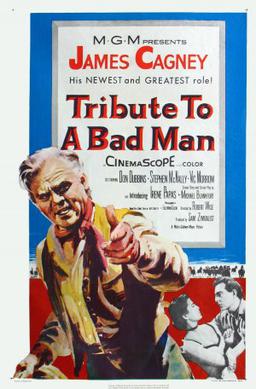
Tribute to a Bad Man is a 1956 American Western film directed by Robert Wise and starring James Cagney about a rancher whose harsh enforcement of frontier justice alienates the woman he loves. It was based on the short story "Hanging's for the Lucky" by Jack Schaefer, the author of Shane.
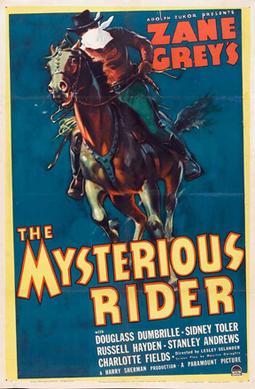
The Mysterious Rider is a 1938 American Western film directed by Lesley Selander and starring Douglass Dumbrille, Sidney Toler, and Russell Hayden. Written by Maurice Geraghty based on the 1921 novel The Mysterious Rider by Zane Gray, the film is about a notorious outlaw who returns to the ranch he once owned and takes a job disguised as a ranch hand. Unrecognized by the ranch's current owner, he waits patiently for an opportunity to expose the men who murdered his partner twenty years ago, framed him for the crime, and then stole his ranch. The film was later released for television in the United States as Mark of the Avenger.

Adventures of Gallant Bess is a 1948 American contemporary western film directed by Lew Landers and starring Cameron Mitchell, Audrey Long, Fuzzy Knight, James Millican, and John Harmon. It was filmed in Cinecolor. It has no connection to the 1947 Metro-Goldwyn-Mayer film Gallant Bess, though publicity stated that "Bess the Wonder Horse" from the earlier film was also in this film.
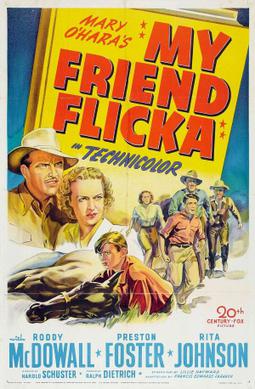
My Friend Flicka is a 1943 American Western film about a young boy, played by Roddy McDowall, who is given a young horse to raise. It is based on Mary O'Hara's popular 1941 children's novel of the same name. Thunderhead, Son of Flicka, released on March 15, 1945, was the sequel to My Friend Flicka.
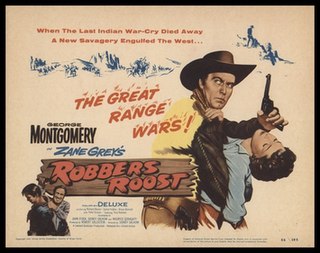
Robbers' Roost is a 1955 American Western film directed by Sidney Salkow and written by John O'Dea, Sidney Salkow and Maurice Geraghty. The film stars George Montgomery, Richard Boone, Sylvia Findley, Bruce Bennett, Peter Graves and Tony Romano. It is based on the 1932 novel Robbers' Roost by Zane Grey. The film was released on May 30, 1955, by United Artists.

William Thomas Waggoner was an American rancher, oilman, banker, horsebreeder and philanthropist from Texas. He was the owner of the Waggoner Ranch, where he found oil in 1903. He was the founding president of the Waggoner National Bank of Vernon. He established the Arlington Downs and paid for the construction of three buildings on the campus of Texas Woman's University.
Matthew Rapf was an American film and television producer and screenwriter. He was best known for producing The Loretta Young Show, Ben Casey, and Kojak.
















